
20.08.2018
Philosopher Paula Fleisner reviews the work of Claudia Fontes which was part of the 57th Venice Art Biennial to question the anthropocentrism and capitalist speciesism with which the Argentine identity has been built.
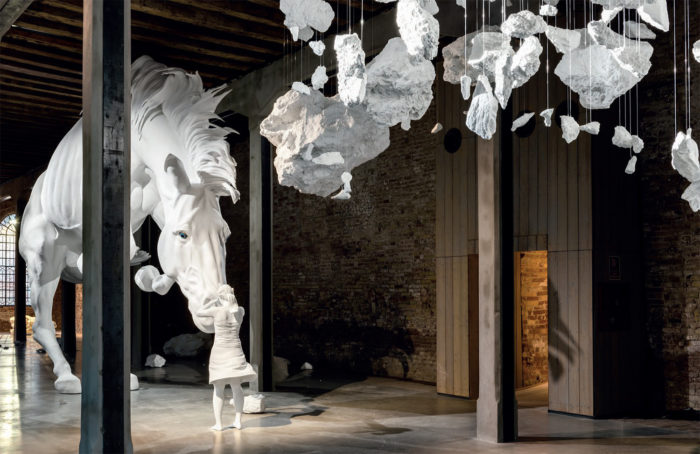
The Horse, the Woman, the Boy and the Stones: Equine Materialism, Feminist Anti-Speciesism, and Mineral Post-Humanism in Claudia Fontes’ Work
The Problem
The installation selected for the Argentinian pavilion at the 2017 57th Venice Biennale was Claudia Fontes’s The Horse Problem. This sculptural work was specifically designed to occupy the Sale d’Armi, a room formerly used to cast bullets and cannons, store guns, and build ships, and that Argentina has rented for the Biennale since 2012. The agitated scene, like a photogram immobilizing movement in the middle of an explosion or some sort of stampede, is formed of white material that has been shaped into an unreasonably large prancing horse with glass eyes. A life-size woman stands facing it, covering her eyes with one hand, and touching the horse with her other, larger hand. A little further, a boy squats, one hand touching the ground, the other holding a stone. He has picked the stone up from the ground, where other stones of different sizes are scattered, and is looking at it through the hair that falls across his face. The rest of the piece is a series of rough, different-sized stones; most hang from the ceiling in front of the horse, projecting a disintegrated, presumably equine shadow on a white wall, while others are scattered on the ground. There is something pressing about the scene. We can perceive movement in the arrested image. Something that is not representation (for the relationship between model and copy is perverted), but a presentation, a critical apparition. A sculpted gesture that interrupts the logic of the symbolic reference between mediums and ends to expose the pure mediality (potential) of the resinous matter that shapes it. [1]
The exhibition’s catalogue includes four essays, a conversation between the curator, Andrés Duprat, and the artist, and a series of pictures with details of the installation. [2] In the essays, the experts discuss the work’s most relevant and perturbing aspects. The outcome is that the “problem” always appears to be solved, be it the issue of the image turned icon; the sustaining of all founding myths (Duprat); or that of the specularities diluting the gigantic equine material in the-horse-within- you (Ternavasio); the problem of the horse’s transformation into an obsolete functionary under contemporary capitalism (Giorgi); or, finally, the problem of the effects of colonization (Ruiz). Yet there is a nagging temptation to pursue another minor and interrupted reading that, perhaps arbitrarily, superimposes new problems and reconsiders, not without distortion, the available interpretations. What if the work also invites us to question the idealism, the andro/anthropocentrism, and the capitalist speciesism looming behind the bio-zoo-hyle-political [3] construction of Argentinian identity?
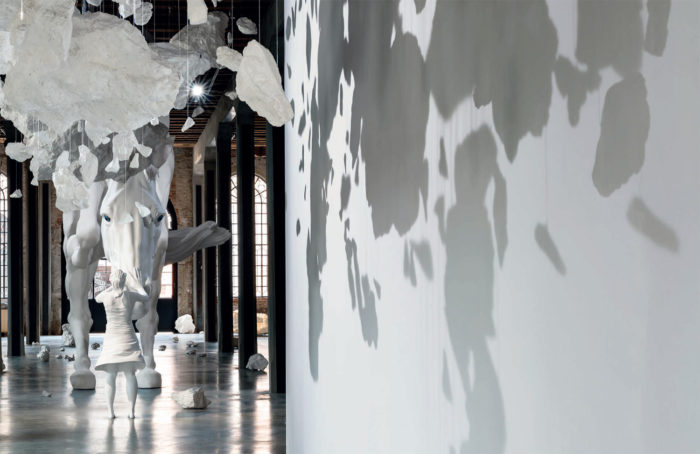
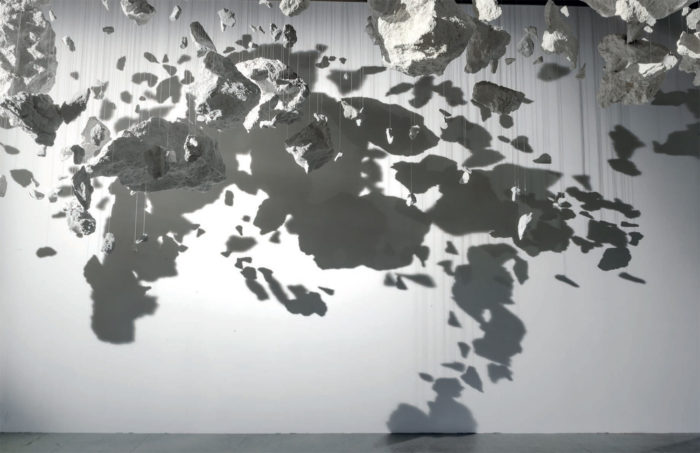
Material Horse
There is a horse. A huge, prancing horse, with a flying mane and tense muscles.
The Horse, if I may use the eidetic capital, has been an undeniable protagonist in the real and symbolic violence upon which Argentina’s oldest identities were built. It is a recurrent theme in literature, music and, more generally, art. The horse was introduced to the American landscape as part of a concrete plan of domination that included animal colonialism, and it was later conscripted into building the Argentinian nation, fusing with its rider—the gaucho, the native, or the patriotic criollo hero, depending on the case and the function—who is nevertheless always the one who guides him. This may be the reason why, when looking at Fontes’s horse, we always “see” the rider’s absence first, and, as a result, a symbolic dialogue between the artist and the discourses that call for the presence of horses in representations of the nation’s construction [4]—a presence that can also be mentally represented as an absence, a “repressed nucleus.” [5] But this horse has no reins, no saddle, and there is no male adult around to claim the subject/rider/center’s position. Why should the problem be reduced to the symbolic signification of an absence?
There is a horse. Not a symbol guarding signifiers of identity (metaphor, allegory, or the representation of another ideal or abstract thing). What if the horse were a symptom? “Síntoma: señal de que algo está sucediendo o está por suceder” [Symptom: an indication that something is happening or is about to happen], according to the second edition of the Diccionario de la Real Academia Española. Or, according to Paco Vidarte’s suggested etymology: “Symptom comes from the Greek words sin-pípto [ind.: pet-], which means ‘to fall together,’ ‘to coincide.’ It designates something as simple as two things falling together, one beside the other, two things coinciding.” [6] This means, on the one hand, that the horse itself is a sign of imminence, and, on the other, that the contiguity between the horse giant and any other body (equine or not) is a coincidence in a closer material world where things fall beside one another fortuitously. A coinciding of vulnerable and shared materiality, inviting a reconsideration of the relationships between the bodies and their affects, as well as all bio-zoo-hyle-political [7] relationships, to deconstruct the invented binarism that deems itself both originating and occult. Here, the horse is the symptom of a redistribution of values, qualities, and agencies, involving everything from the woman to the stones, to break with andro/anthropocentrist idealism and its immunitarian-identitarian logic: nothing will be an available body for the reproduction of the system, raw material or natural resource—at least not without resistance. Maybe this is an equine call to revolt.
An apotheosized, gigantic, and powerful material that can no longer be retranslated into the idiotic (I-ish) discourse of the sublime: in the face of this work of art, no subject leaves with its dignity as dweller in the realm of ends strengthened. Looking at us through its enormous glass eyes that break with the rigorous white marble of the ensemble, this horse, neither Platonic nor Kantian, is not an agent of hominization, but rather the herald of its dissolution.
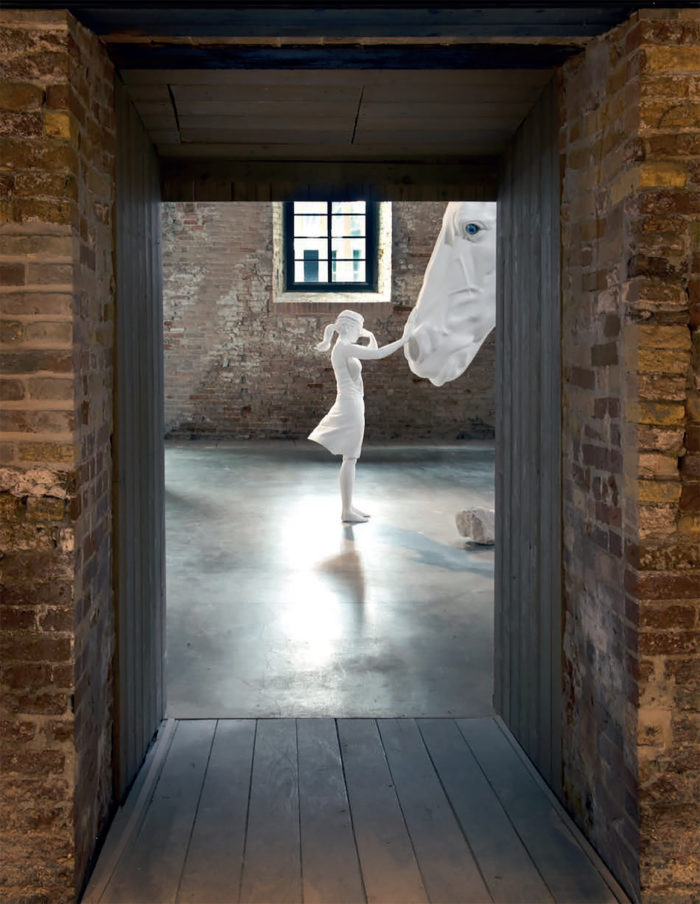
(Ab)solved Woman
There is a woman. A young woman, wearing a skirt and a floating ponytail. She stands barefoot facing the horse, touching its muzzle with one hand and covering her eyes with the other.
Woman, if I am allowed to use the idealist capital again, has also played her role in the construction of Argentinite identity, practically and symbolically. Actually, not only in Argentina. Far from the rider and the center, before crossing the Atlantic Ocean, the female human animal was always closer to nonhuman animals which, like her, are not subjects but only objects at the mercy of the calculating dominion of the male. [8] Theirs are lives deprived of shape by a sovereign machine that transforms them into consumable identities through inclusive exclusion. [9] The woman is therefore the contiguous point at which speciesist idealism (the ideology that asserts the supremacy of the human species through the attribution of an ideal exceptionality) and patriarchal capitalism (the rise of the ability to reproduce the Western mode of production) meet. As a source of (re)creation of new working forces and of mechanisms for the construction of the dominant virile identity, women, like animals, seem to exist in order to be somehow “consumed.”
There is a woman. Is she a captive? That feminine character, recurring in imagery from the Conquest of the Desert [10], who crosses the threshold of barbaric worlds, seminude on a horse, dragged behind by raiders? No. Fontes’s woman is not naked, nor passively accepting her destiny as secondary to the rider (whether he be native or criollo, since in both cases she would be mere property, and could eventually change masters). In the middle of the dazzling scene, she faces the powerful horse with her small body and proffers her caressing hand, without pondering (without looking, actually). She does not contemplate, she touches.
Could she be a nymph, the survival of a pathetic formula (Pathosformeln) revealed in the movement of the clothes and the hair (as Warburg saw in Boticelli’s Venus) guaranteeing in this movement a certain anachronistic affective continuity. [11] This pathos as a survivor of a remote time, possibly the memory of a non-speciesist and non-patriarcal inter-reigns coexistence. Beyond Warburg and the sublimated desire for sexual violence contained in his idea of the nymph, an impersonal and post-human affectivity [12] could be argued for for Fontes’s nymph: a cosmic empathy (Einfühlung) in the acknowledgement of the other’s pain, a flux of non-specific affectivities (a human animal of feminine-horse gender) which erases, as in a curative imposition of hands, the sedimented layers of the availability and domination of all that exists. With her out-of-scale hand, the woman touches the horse and breaks the hierarchical system of domination that arose to sustain the sovereign primacy of the (male) rider who builds the nation, equally disposing of women, animals and desert. Like a mare (in Spanish: yegua, a common Rioplatense insult to refer to a bad woman), the woman has suspended her patriarchal finality (she is not captive nor mother nor virgin nor whore), and gives herself to the exhibition of her sole tactile mediality.
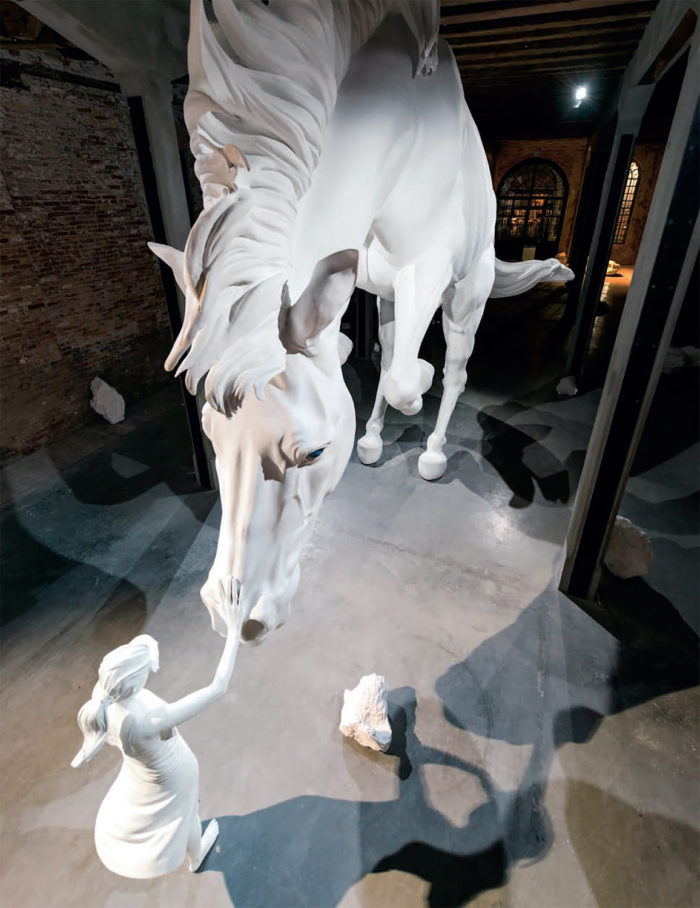
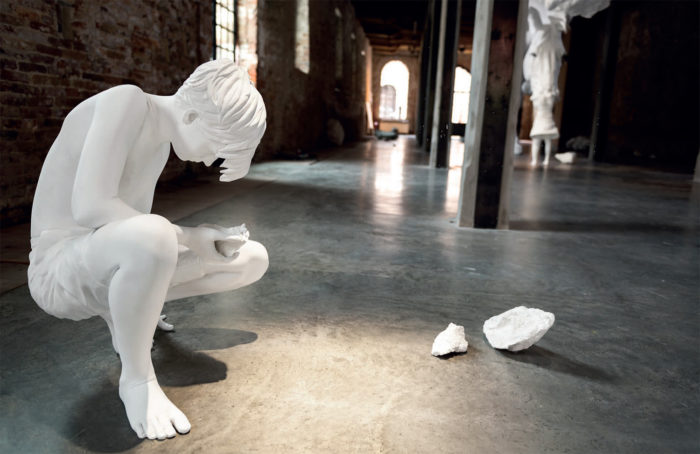
Stones and Child
There is a boy. There are also 400 stones, a few scattered on the floor and many more suspended in mid-air. Stones and boy: absence of world (Weltlosigkeit) [13] and language (in-fancy)? Inhumane a-mundanity that throws us even farther from the immunitary circle of the nation’s constructor and conductor rider-subject. A squatting boy looking at the stone he just picked from the ground. And a cloud of stones throwing what could be a disarticulated equine shadow on the white wall—like the last sneer of Plato’s cave denouncing the emancipation of the shadow from the model. Another fortuitous continuity, sustained not in the reference to an ordaining absence, but in the material presence that is distributed, in a novel way, across a space that cannot be interiorized.
“Throw a stone, and you will destroy an ontology, leaving all taxonomy scattered in gleaming fragments,” says J.J. Cohen in his introduction to his book about stones. [14] Maybe this is what the boy holding the stone is thinking. Not a reflection on the remains of an incomprehensible history, but the threshold of a decision about the future: the ruin becoming projectile. The imminence of a youthful and subversive throwing of the stone.
In the Arsenal, where dominance was invented, stones began to fall from the sky, and, as if it were the cycle of water, they hold the promise of a revolt in their apparent silence. Memories of an abiotic past, not anthropic and unfathomable, but prior to all hierarchical distributions of specific agencies. Stones are not dead matter, nor docile tools [15], but the inhuman strength that guarantees the coming to action and reveals the continuity of all that exists (all the pieces of the scene are, ultimately, made of the same material). The lithic hope of a humanism to come.

Decolonize
Fontes admits that the need to find strategies of decolonization is a recurring obsession in her artistic practice. In the sculptural scene of The Horse Problem, the strategy could involve leaving behind the periphery’s claim to the center, i.e., abandoning the quest to become “subject” (and by the same token European, male, white, heterosexual, etc.). Against all partial intention to broaden the circle of immunity and finally let the horse, the woman, and the boy step in, the work seems to be presenting a lithic becoming whole, implying that a revolt against the enlightenment myth that brought about planetary domination and the absolute availability of all the bodies is to be expected.
The problematic challenge for both thought and art is, I believe, to grab the tools of post-humanist movements, of materialist aesthetics, and of Latin American anthropology’s perspectivism to abandon once and for all the speciesist and patriarcal idealism that has aestheticized animals and women and robbed children and stones of their voices to the point that they have become pristine symbols (evocations of a total order) and “raw,” inert material (bodies available to the use of man-male). The post-humanist materialism of the perspective I am promoting denounces speciesism as a symbolic and material system of production, sustained by the invention of an immune and unpunished center. All its masks must be attacked. From this perspective, Fontes’s work breaks with traditional categories of European philosophical aesthetics, beauty, and the sublime to imagine a politics of existence founded on a sympoiesis [16], a doing-with of the materialities populating the planet. This may be the only way in which the 57th Venice Biennale’s premise can be interpreted without a bad conscience: “To celebrate art as a strategy for survival.”

—
[1] Giorgio Agambem, Mezzi senza fine. Note sulla politica (Torino: Bollati Boringhieri, 1996).
[2] Claudia Fontes, El problema del caballo. The Horse Problem, Ministry of Foreign Affairs and Worship of the Argentine Republic on the occasion of Claudia Fontes’s exhibition The Horse Problem at the Argentinian Pavilion for the 57th International Art Exhibition, Biennale Arte 2017. May 13–November 26, 2017. With essays by: Andrés Duprat, Aldo Ternavasio, Gabriel Giorgi, and Pablo Martín Ruíz.
[3] I added the word hyle to include inorganic matter in the politics of management of the living (human or animal), for it is also subjected to it.
[4] For instance, Andrés Duprat’s analysis of Ángel della Valle’s La vuelta del malón/The Return of the Indian Raid (1892) in his essay “The Horse and the Man” in the exhibition’s catalogue. See Fontes, 14. The other essays also discuss the other works presumably referred to by Fontes.
[5] In Un desierto para la nación [A Desert for the Nation], Fermín Rodriguez discusses a scene from Nadie, nada, nunca [Nobody, Nothing, Never], a novel by J. J. Saer, where horses are killed for no apparent reason: “The reality of that which is Argentinian, encrypted in the rural landscape, is only a veil covering something that has not yet stopped from happening, a repressed nucleus on which the nation is founded.” The Heideggerian rhetoric of occultation/nonun-occultation seems to be repeating itself in Fontes’s work through the idea of the rider’s absence. Fermín Rodríguez, Un desierto para la nación (Buenos Aires: Eterna Cedencia, 2010), 340.
[6] Paco Vidarte, Derridaladacan: contigüidades sintomáticas. Sobre el objeto pequeño jacques. Conference held on October 19, 2006 in Buenos Aires in the frame of the 5th International Symposium on Nietzsche and 1st International Symposium on Derrida. Retrieved on May 1st, 2018 (available in Spanish): https://redaprenderycambiar.com.ar/derrida/comentarios/derridalacan.htm
[7] Fontes claims that her artistic interest stems from the biopolitical context (which seems to think at least for nonhuman animals and humans alike). She stresses the importance of the material (both of the construction of the place of the installation and the material relationship of her work’s elements). See “Conversación entre Andrés Duprat y Claudia Fontes” in Fontes, 105-106.
[8] Theodor W. Adorno and Max Horkheimer, “Hombre y animal” en La dialéctica de la Ilustración (Spanish edition), trans. J. J. Sánchez (Madrid: Trotta, 1998), 291-299.
[9] Giorgio Agamben, L’aperto, l’uomo e l’animale (Torino: Bollatti Boringhieri, 2002).
[10] The ”’Conquest of the Desert”’ (in Spanish, Conquista del desierto) was a barbaric military campaign directed mainly by General Julio Argentino Roca in the 1870s with the intent to establish Argentine dominance over Patagonia, which implicated the genocide of indigenous people who inhabited the region.
[11] Aby Warburg, La pervivencia de las imágenes (Spanish edition) sel. and trans. F. Santos. (Buenos Aires: Miluno, 2014), 217.
[12] Fabián Ludueña Romandini presents a reading in non-human code of the transmitted affectivity of the Pathosformeln to which I am indebted here. See Fabián Ludueña Romandini, “Eternidad, espectralidad, ontología: hacia una estética trans-objetual” in Badiou, Alain, Pequeño manual de inestética (Buenos Aires: Prometeo, 2009), 19.
[13] I am obviously referring to Heidegger’s hierarchy of beings according to their mundanity: men are builders of the world (weltbilden), animals are poor in world (weltarm), and the stones lack the world (weltlos). Martin Heidegger, Los conceptos fundamentales de la metafísica. Mundo, finitud, soledad, (Spanish edition) trans. A. Ciria (Madrid: Alianza, 2007), 224-233.
[14] Jeffrey J. Cohen, Stone. An Ecology of the Inhuman (Minneapolis/London: University of Minnesota Press, 2015), 1.
[15] Jeffrey J. Cohen, Stone. An Ecology of the Inhuman (Minneapolis/London: University of Minnesota Press, 2015), 4.
[16] Donna Haraway, “Symbiogenesis, Sympoiesis, and Art Science Activisms for Staying with the Trouble,” in Anna Tsing, et.al. (eds.), Arts of Living on a Damaged Planet (Minneapolis/London: Minnesota University Press, 2017), 25-50.
Comments
There are no coments available.